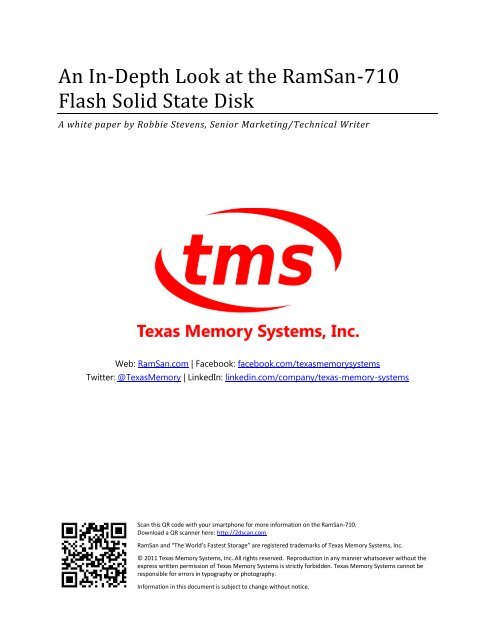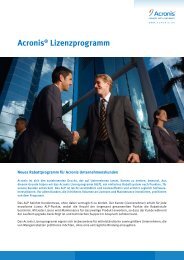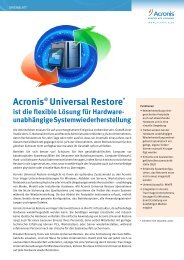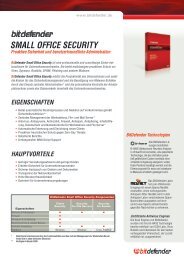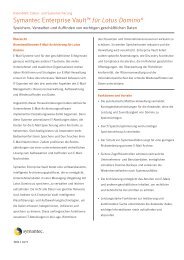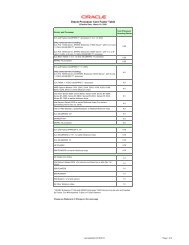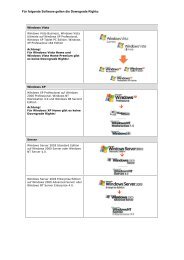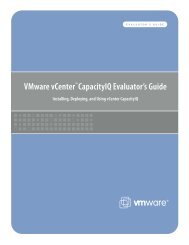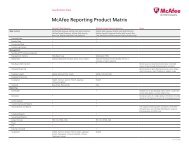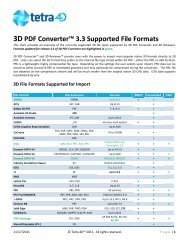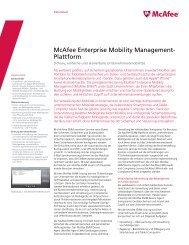A Closer Look at the RamSan-710
A Closer Look at the RamSan-710
A Closer Look at the RamSan-710
You also want an ePaper? Increase the reach of your titles
YUMPU automatically turns print PDFs into web optimized ePapers that Google loves.
An In-Depth <strong>Look</strong> <strong>at</strong> <strong>the</strong> <strong>RamSan</strong>-<strong>710</strong><br />
Flash Solid St<strong>at</strong>e Disk<br />
A white paper by Robbie Stevens, Senior Marketing/Technical Writer<br />
Web: <strong>RamSan</strong>.com | Facebook: facebook.com/texasmemorysystems<br />
Twitter: @TexasMemory | LinkedIn: linkedin.com/company/texas-memory-systems<br />
Scan this QR code with your smartphone for more inform<strong>at</strong>ion on <strong>the</strong> <strong>RamSan</strong>-<strong>710</strong>.<br />
Download a QR scanner here: http://2dscan.com<br />
<strong>RamSan</strong> and “The World’s Fastest Storage” are registered trademarks of Texas Memory Systems, Inc.<br />
© 2011 Texas Memory Systems, Inc..All rights reserved. Reproduction in any manner wh<strong>at</strong>soever without <strong>the</strong><br />
express written permission of Texas Memory Systems is strictly forbidden. Texas Memory Systems cannot be<br />
responsible for errors in typography or photography.<br />
Inform<strong>at</strong>ion in this document is subject to change without notice.
Table of Contents<br />
Introduction .................................................................................................................. 4<br />
A <strong>Closer</strong> <strong>Look</strong> <strong>at</strong> <strong>the</strong> <strong>RamSan</strong>-<strong>710</strong> ................................................................................ 6<br />
Performance ................................................................................................................. 8<br />
Bandwidth ................................................................................................. 9<br />
I/Os per Second (IOPS) .............................................................................. 9<br />
L<strong>at</strong>ency and I/O ....................................................................................... 10<br />
Connectivity ................................................................................................................ 11<br />
SAN Connectivity .................................................................................... 11<br />
Fibre Channel .......................................................................................... 12<br />
InfiniBand ................................................................................................ 13<br />
Reliability .................................................................................................................... 14<br />
Three Layers of Flash Memory Protection.............................................. 14<br />
Layer 1: ECC for Flash Memory .................................................. 14<br />
Layer 2: Variable Stripe RAID for Flash Memory ....................... 14<br />
Layer 3: Active Spare (system-level) Optional ........................... 14<br />
Flash Wear Leveling ................................................................................ 15<br />
Ultra-Capacitors ...................................................................................... 15<br />
Fault Isol<strong>at</strong>ion ......................................................................................... 16<br />
Capacity ...................................................................................................................... 17<br />
Availability .................................................................................................................. 18<br />
Scalability .................................................................................................................... 19<br />
Manageability ............................................................................................................. 20<br />
For More Inform<strong>at</strong>ion ................................................................................................ 22
Table of Figures<br />
The <strong>RamSan</strong>-<strong>710</strong>........................................................................................................... 4<br />
<strong>RamSan</strong>-<strong>710</strong> Architecture Diagram .............................................................................. 6<br />
Back Connectivity of <strong>the</strong> <strong>RamSan</strong>-<strong>710</strong> ....................................................................... 12<br />
Inside <strong>the</strong> <strong>RamSan</strong>-<strong>710</strong> ............................................................................................... 16<br />
Browser Configur<strong>at</strong>ion Interface (System Inform<strong>at</strong>ion) ............................................. 20
Introduction<br />
The Texas Memory Systems <strong>RamSan</strong>® line of solid st<strong>at</strong>e disks (SSDs) has always<br />
domin<strong>at</strong>ed <strong>the</strong> performance end of <strong>the</strong> storage spectrum. Th<strong>at</strong> performance<br />
dominance continues with <strong>the</strong> new Texas Memory Systems Series-7 family. The<br />
<strong>RamSan</strong>-<strong>710</strong> offers up to 5.15 TB of capacity in a 1U chassis th<strong>at</strong> typically draws 280<br />
w<strong>at</strong>ts of power.<br />
FIGURE 1: THE RAMSAN-<strong>710</strong><br />
The <strong>RamSan</strong>-<strong>710</strong> blows away 15K RPM hard disk drive arrays in density, cost, and<br />
reliability while offering stunning performance and power efficiency. This SSD<br />
leverages gener<strong>at</strong>ions of backplane, interface, and reliability experience designed<br />
into <strong>RamSan</strong> solid st<strong>at</strong>e disks (SSD).The <strong>RamSan</strong>-<strong>710</strong> has <strong>the</strong> following key fe<strong>at</strong>ures:<br />
The World's Fastest Storage®: Sustained I/O r<strong>at</strong>es up to 400,000 IOPS for reads<br />
or writes and sustained, random bandwidth up to 5 GB/second.<br />
Next-Gener<strong>at</strong>ion Series-7 Product Family: <strong>RamSan</strong> Series-7 is <strong>the</strong> 7th<br />
gener<strong>at</strong>ion of <strong>the</strong> <strong>RamSan</strong> product family, origin<strong>at</strong>ing from <strong>the</strong> first <strong>RamSan</strong> in<br />
2000. All Series-7 <strong>RamSan</strong> products deliver cost-effective performance and<br />
reliability.<br />
Series-7 Flash Controller: One key to <strong>the</strong> uncompromising performance of<br />
Series-7 products is <strong>the</strong> Series-7 Flash Controller. Based on high-performance<br />
Xilinx FPGAs and a PowerPC processor, <strong>the</strong> Series-7 Flash Controller is fieldupgradable,<br />
ensuring th<strong>at</strong> TMS customers will always have <strong>the</strong> best<br />
performance and l<strong>at</strong>est fe<strong>at</strong>ures.<br />
Variable Stripe RAID (VSR): VSR is a p<strong>at</strong>ented technology only available to<br />
TMS customers th<strong>at</strong> drastically reduces wasted planes. If a plane fails, VSR<br />
autom<strong>at</strong>ically rebuilds and reloc<strong>at</strong>es <strong>the</strong> d<strong>at</strong>a from th<strong>at</strong> plane. It <strong>the</strong>n allows<br />
d<strong>at</strong>a to be rewritten to <strong>the</strong> area, dynamically altering <strong>the</strong> size of <strong>the</strong> stripe to<br />
avoid <strong>the</strong> failed plane. Under traditional RAID schemes, <strong>the</strong> entire stripe would<br />
have been unusable and all its remaining good planes would have been lost.<br />
8 Gbit Fibre Channel: The <strong>RamSan</strong>-<strong>710</strong> comes with new dual ported 8 Gbit Fibre<br />
Channel controllers.<br />
QDR InfiniBand: The <strong>RamSan</strong>-<strong>710</strong> can be equipped with up to two QDR<br />
InfiniBand ports.<br />
July 2011 4 Texas Memory Systems
Fault Tolerant Flash (FTF): The Flash used in <strong>the</strong> <strong>RamSan</strong>-<strong>710</strong> is enterprise grade<br />
SLC Flash. Each Flash card in <strong>the</strong> <strong>RamSan</strong>-<strong>710</strong> includes on-board RAID protection<br />
to protect against chip failure. In addition, an advanced chip-level ECC provides<br />
multiple regions of bit correction per block.<br />
Active Spare: One FTF card can be design<strong>at</strong>ed as an active-spare th<strong>at</strong> works<br />
hand-in-hand with <strong>the</strong> chip level RAID. If one of <strong>the</strong> cards experiences a failure<br />
th<strong>at</strong> degrades its RAID protection, <strong>the</strong> system will immedi<strong>at</strong>ely migr<strong>at</strong>e <strong>the</strong> d<strong>at</strong>a<br />
on th<strong>at</strong> card to <strong>the</strong> hot-spare to return to a fully redundant st<strong>at</strong>e.<br />
Wear Leveling: The <strong>RamSan</strong>-<strong>710</strong> includes wear-leveling technology th<strong>at</strong><br />
protects <strong>the</strong> underlying Flash media by spreading out writes and maximizing <strong>the</strong><br />
write life of <strong>the</strong> system.<br />
Completely Non-Vol<strong>at</strong>ile: Flash memory is inherently non-vol<strong>at</strong>ile. Ultra<br />
capacitors are incorpor<strong>at</strong>ed into <strong>the</strong> design anywhere RAM buffers are used<br />
with enough power to synchronize <strong>the</strong> buffers to Flash.<br />
Unparalleled Scalability: A single 1U chassis upgrades from 1 to 5 TB of Flash<br />
storage and two Fibre Channel ports or two InfiniBand ports. Multiple units can<br />
be added to meet any capacity or performance requirement.<br />
Low Power: The <strong>RamSan</strong>-<strong>710</strong> typically uses only 280 w<strong>at</strong>ts of power.<br />
July 2011 5 Texas Memory Systems
A <strong>Closer</strong> <strong>Look</strong> <strong>at</strong> <strong>the</strong> <strong>RamSan</strong>-<strong>710</strong><br />
FIGURE 2: RAMSAN-<strong>710</strong> ARCHITECTURE DIAGRAM<br />
Enclosed in <strong>the</strong> <strong>RamSan</strong>-<strong>710</strong> are 21 cards, each containing 20 SLC Flash memory<br />
chips (420 chips total). The key fe<strong>at</strong>ures of <strong>the</strong>se Flash cards are explained in more<br />
detail below:<br />
The <strong>RamSan</strong>-<strong>710</strong> provides on-board hardware-based Variable Stripe RAID<br />
deployed across all Flash chips for maximum d<strong>at</strong>a protection. On each board in<br />
<strong>the</strong> <strong>RamSan</strong>-<strong>710</strong>, a dedic<strong>at</strong>ed Series-7 Flash Controller manages 20 chips. A<br />
<strong>RamSan</strong>-<strong>710</strong> has 21 total internal RAID groups and 420 Flash elements all<br />
working in parallel. This architecture allows for resiliency while delivering<br />
industry-leading performance.<br />
To ensure enterprise-grade performance and reliability, TMS chose SLC NAND<br />
Flash for <strong>the</strong> <strong>RamSan</strong>-<strong>710</strong>. MLC (Multi-level Cell) Flash offers some storage<br />
density and cost advantages, but its write endurance specific<strong>at</strong>ion is ten times<br />
less than SLC, and its write performance is slower as well, making it<br />
unacceptable for mission critical enterprise deployments.<br />
The <strong>RamSan</strong>-<strong>710</strong> has up to 6.87 TB of “raw” Flash storage, over 30% more than<br />
<strong>the</strong> 5.15 TB of advertised usable space. The extra Flash storage enhances both<br />
<strong>the</strong> performance and <strong>the</strong> reliability. A process called “wear leveling” spreads<br />
d<strong>at</strong>a writes evenly over all <strong>the</strong> Flash blocks, dram<strong>at</strong>ically increasing <strong>the</strong> Flash<br />
July 2011 6 Texas Memory Systems
media endurance; plus, <strong>the</strong> extra storage ensures th<strong>at</strong> pre-erased Flash blocks<br />
are always available, acceler<strong>at</strong>ing write performance.<br />
The <strong>RamSan</strong>-<strong>710</strong> incorpor<strong>at</strong>es a small amount of RAM which is also involved in<br />
acceler<strong>at</strong>ing write speeds. Because RAM has much lower d<strong>at</strong>a access times<br />
(l<strong>at</strong>ency) than Flash, storing <strong>the</strong> Flash transl<strong>at</strong>ion table on RAM significantly<br />
improves write performance. The RAM is also used as a buffer to help queue<br />
and manage writes to <strong>the</strong> Flash maximizing write efficiencies.<br />
To protect <strong>the</strong> d<strong>at</strong>a as it moves through <strong>the</strong> RAM buffers, <strong>the</strong> <strong>RamSan</strong>-<strong>710</strong><br />
includes super capacitors th<strong>at</strong> hold significantly more charge than needed to<br />
flush <strong>the</strong> RAM to persistent Flash. Thanks to <strong>the</strong> ultra capacitors, you could<br />
actually unplug <strong>the</strong> <strong>RamSan</strong>-<strong>710</strong> from its host without warning or prepar<strong>at</strong>ion<br />
and lose no d<strong>at</strong>a.<br />
July 2011 7 Texas Memory Systems
Performance<br />
Performance is key to a quality SSD. The <strong>RamSan</strong>-<strong>710</strong> is <strong>the</strong> l<strong>at</strong>est SSD from TMS,<br />
maintaining <strong>the</strong> <strong>RamSan</strong> line’s position as <strong>the</strong> World’s Fastest Storage®. The<br />
<strong>RamSan</strong>-<strong>710</strong> boasts <strong>the</strong> following key performance metrics:<br />
35 microsecond access time (writes)<br />
175 microsecond access time (reads)<br />
400,000 sustained random IOPS (writes)<br />
400,000 sustained random IOPS (reads)<br />
5 GB/second peak bandwidth<br />
The key measure of <strong>the</strong> <strong>RamSan</strong>-<strong>710</strong>’s capabilities is its ability to sustain extreme<br />
inputs/outputs per second (IOPS) even with mixed read/write workloads. This is<br />
important because most applic<strong>at</strong>ions have a mixture of reads and writes with a<br />
gre<strong>at</strong> deal of random access. Most o<strong>the</strong>r Flash SSDs and hard disk drive (HDD)<br />
solutions suffer significant performance degrad<strong>at</strong>ion from ei<strong>the</strong>r random access<br />
p<strong>at</strong>terns or write accesses, if not both. For example, most Flash SSDs suffer<br />
disproportion<strong>at</strong>ely if <strong>the</strong>y experience even a small percentage of writes, to <strong>the</strong> point<br />
th<strong>at</strong> <strong>the</strong>ir mixed read/write performance may actually be dram<strong>at</strong>ically less than<br />
<strong>the</strong>ir peak write performance. In practice, this means th<strong>at</strong> a <strong>RamSan</strong>-<strong>710</strong> will deliver<br />
better sustained “real world” random read/write applic<strong>at</strong>ion performance than any<br />
o<strong>the</strong>r Flash SSD.<br />
And if o<strong>the</strong>r Flash SSDs have difficulty competing with <strong>the</strong> performance of <strong>the</strong><br />
<strong>RamSan</strong>-<strong>710</strong>, hard disk drives can’t even get in <strong>the</strong> ballpark. Consider this: high<br />
performance 15K RPM Fibre Channel (FC) HDDs can achieve <strong>at</strong> best 300 IOPS. At<br />
th<strong>at</strong> IOPS r<strong>at</strong>e, it would take well over 1,300 HDDs to equal <strong>the</strong> performance of one<br />
<strong>RamSan</strong>-<strong>710</strong>. This means almost 100 disk enclosures in seven racks, all of which<br />
would draw over 16,000 w<strong>at</strong>ts, while one <strong>RamSan</strong>-<strong>710</strong> uses 280!<br />
You can also compare HDD to <strong>the</strong> <strong>RamSan</strong>-<strong>710</strong> on <strong>the</strong> basis of capacity and<br />
performance. The highest-performing 15K RPM FC HDDs usually provide 146 GB of<br />
capacity. One disk enclosure would offer 2 TB of “raw” storage, but deploying <strong>the</strong>se<br />
drives in RAID 10 sets for performance and reliability would actually offer only 1 TB<br />
of usable capacity for each 3U 14 drive disk enclosure. To equal <strong>the</strong> <strong>RamSan</strong>-<strong>710</strong>’s<br />
5 TB capacity you would need five of <strong>the</strong>se enclosures and 70 disks. Combined with<br />
<strong>the</strong> controller (ano<strong>the</strong>r 3U), <strong>the</strong> full disk solution would require 18U (half a rack),<br />
draw around 2,000 w<strong>at</strong>ts, and provide only a few percent of <strong>the</strong> performance of <strong>the</strong><br />
<strong>RamSan</strong>-<strong>710</strong>. Perhaps most surprisingly, if you include <strong>the</strong> power, space, and cooling<br />
costs with <strong>the</strong> upfront acquisition costs of a disk controller with 70 disks, <strong>the</strong><br />
<strong>RamSan</strong>-<strong>710</strong> may be <strong>the</strong> LESS expensive solution.<br />
July 2011 8 Texas Memory Systems
Bandwidth<br />
Maximum d<strong>at</strong>a throughput is ano<strong>the</strong>r key performance metric. The <strong>RamSan</strong>-<strong>710</strong><br />
delivers its bandwidth to hosts through up to two 8 Gb Fibre Channel interface ports<br />
or two QDR InfiniBand ports. Its high bandwidth offers two main benefits:<br />
High bandwidth enables administr<strong>at</strong>ors to share <strong>the</strong> <strong>RamSan</strong>-<strong>710</strong> across<br />
multiple hosts without affecting performance.<br />
Some applic<strong>at</strong>ions require high bandwidth, including video on demand, d<strong>at</strong>a<br />
warehousing, and non-linear editing of HDTV.<br />
Competing SSDs offer far less bandwidth than <strong>the</strong> <strong>RamSan</strong>-<strong>710</strong>, cannot support all<br />
of <strong>the</strong> applic<strong>at</strong>ions <strong>the</strong> <strong>RamSan</strong> supports, and cannot be shared with as many hosts.<br />
An important fe<strong>at</strong>ure of <strong>the</strong> <strong>RamSan</strong>-<strong>710</strong> is th<strong>at</strong> it provides this massive 5 GB/s<br />
bandwidth in a 1U form factor th<strong>at</strong> also offers up to 5.15 TB of capacity drawing 280<br />
w<strong>at</strong>ts and weighing 25 pounds. An HDD-based system would need <strong>at</strong> least 100<br />
drives to m<strong>at</strong>ch this bandwidth, take up 24U of rack space, and draw almost 1,300<br />
w<strong>at</strong>ts. An important note to keep in mind as you compare <strong>the</strong> <strong>RamSan</strong> to HDD RAID:<br />
our solid st<strong>at</strong>e disk can sustain its bandwidth numbers with random d<strong>at</strong>a streams.<br />
Conversely, HDD RAID systems can only sustain high bandwidth numbers with<br />
sequential d<strong>at</strong>a streams.<br />
I/Os per Second (IOPS)<br />
The <strong>RamSan</strong>-<strong>710</strong> can deliver 400,000 random IOPS to your applic<strong>at</strong>ions. We stress<br />
"random IOPS" because HDD RAID manufacturers occasionally cite <strong>the</strong>ir IOPS<br />
performance and discerning buyers should be aware th<strong>at</strong> <strong>the</strong>se quoted numbers<br />
almost always represent sequential IOPS performance. Similarly, if you see Flash<br />
SSD performance quoted, beware th<strong>at</strong> many times <strong>the</strong>se numbers only reflect read<br />
performance, are often based on cache hits, and are not sustainable without<br />
extremely high thread counts to <strong>the</strong> system. Fur<strong>the</strong>r, some Flash manufacturers<br />
quote numbers th<strong>at</strong> are only achievable with odd capacity-constrained<br />
configur<strong>at</strong>ions.<br />
The problem with sequential IOPS is th<strong>at</strong> almost no "real world" applic<strong>at</strong>ions<br />
actually result in sequential small block disk access. So why do you need high<br />
random IOPS? They are needed to process d<strong>at</strong>abase transactions. D<strong>at</strong>abase<br />
transactions have two main characteristics: <strong>the</strong>y are small (typically 4 KB pages), and<br />
<strong>the</strong>y are random. Small random file accesses thrash HDD. In fact, really good HDD<br />
can only provide around 300 random IOPS. Fast HDD RAID systems would need<br />
hundreds of drives to m<strong>at</strong>ch <strong>the</strong> <strong>RamSan</strong>-<strong>710</strong>’s performance, if <strong>the</strong> controller didn’t<br />
become a bottleneck first. The fastest cache built into expensive HDD storage arrays<br />
can handle <strong>at</strong> most 150,000 IOPS, still well below <strong>the</strong> <strong>RamSan</strong>-<strong>710</strong>’s performance<br />
direct to non-vol<strong>at</strong>ile Flash.<br />
July 2011 9 Texas Memory Systems
This brings us to an answer to <strong>the</strong> original question – it is important to support a<br />
high number of IOPS because your servers can produce a high number of IOPS.<br />
When your processor is faster than your storage, <strong>the</strong>n your processor literally waits<br />
on storage for d<strong>at</strong>a needed to perform calcul<strong>at</strong>ions – this is called I/O wait time. If<br />
your processor is waiting, <strong>the</strong>n your users are waiting too. In addition, you are<br />
wasting a significant investment in <strong>the</strong> l<strong>at</strong>est processors and software licenses.<br />
By supplying very high random IOPS, <strong>the</strong> <strong>RamSan</strong>-<strong>710</strong> elimin<strong>at</strong>es I/O wait time for<br />
all of its stored files. Because its random IOPS capabilities are so extraordinary, a<br />
single <strong>RamSan</strong>-<strong>710</strong> can provide I/O acceler<strong>at</strong>ion for multiple host servers.<br />
L<strong>at</strong>ency and I/O<br />
Peak applic<strong>at</strong>ion performance is affected by <strong>the</strong> combin<strong>at</strong>ion of response time<br />
(l<strong>at</strong>ency) and peak I/O <strong>at</strong> certain thread counts, block sizes, and read/write p<strong>at</strong>terns.<br />
HDD RAID systems typically offer 4-8 millisecond access times. To lower response<br />
times and increase performance, HDD RAID systems add RAM or Flash caches to<br />
<strong>the</strong>ir array controllers. These caches can lower l<strong>at</strong>ency to around 0.5 millisecond<br />
access times when <strong>the</strong> requested d<strong>at</strong>a resides in <strong>the</strong> cache, but when it doesn’t and<br />
<strong>the</strong> d<strong>at</strong>a request goes through to <strong>the</strong> back-end disks, <strong>the</strong> l<strong>at</strong>ency returns to 4-8<br />
milliseconds. The <strong>RamSan</strong>-<strong>710</strong>, on <strong>the</strong> o<strong>the</strong>r hand, offers 0.035 millisecond access<br />
times for writes. This is much faster than HDD RAID systems. The <strong>RamSan</strong>-<strong>710</strong><br />
provides 0.175 millisecond access times for reads. This is <strong>at</strong> least 25 times faster<br />
than most HDD RAID systems as well. In fact, in most cases <strong>the</strong> Flash-based <strong>RamSan</strong>-<br />
<strong>710</strong> will return d<strong>at</strong>a faster than <strong>the</strong> cache on RAID subsystems (regardless of <strong>the</strong><br />
type of storage used for <strong>the</strong> cache).<br />
For some customers, this combin<strong>at</strong>ion of low l<strong>at</strong>ency and sustainable I/O is <strong>the</strong> key<br />
to improving applic<strong>at</strong>ion performance.<br />
When you consider <strong>the</strong> <strong>RamSan</strong>-<strong>710</strong>’s blend of high combined bandwidth, fast<br />
random IOPS performance, and extremely low l<strong>at</strong>ency, it is clear why Texas Memory<br />
Systems calls <strong>the</strong> <strong>RamSan</strong> "The World's Fastest Storage®."<br />
July 2011 10 Texas Memory Systems
Connectivity<br />
SAN Connectivity<br />
The field of solid st<strong>at</strong>e disk options has expanded dram<strong>at</strong>ically as <strong>the</strong> cost has come<br />
down. This expansion has included SSD connectivity. Now you can buy SSDs th<strong>at</strong><br />
look like HDD and connect using <strong>the</strong> same protocols. You can also find SSD solutions<br />
such as <strong>the</strong> <strong>RamSan</strong>-<strong>710</strong> th<strong>at</strong> connect using Fibre Channel or Infiniband interfaces<br />
directly to servers or through Storage Area Networks (SAN) and even Network<br />
Attached Storage (NAS) architectures. Most recently, PCIe <strong>at</strong>tached SSD options<br />
such as <strong>the</strong> <strong>RamSan</strong>-70 have appeared on <strong>the</strong> market, offering <strong>the</strong> ability to put a<br />
high performance, high capacity SSD solution entirely within a server.<br />
PCIe connectivity can be a powerful fe<strong>at</strong>ure for high-end workst<strong>at</strong>ions, smaller<br />
reporting d<strong>at</strong>abase systems, and o<strong>the</strong>r environments where an internal solution is<br />
an advantage. It isn’t <strong>the</strong> best solution for every storage requirement, however.<br />
When deploying PCIe-based solutions, <strong>the</strong> SSD capacity becomes locked up in <strong>the</strong><br />
server and limited to <strong>the</strong> number of PCIe expansion slots supplied by <strong>the</strong><br />
manufacturer. Plus, <strong>the</strong> SSD cannot be shared across applic<strong>at</strong>ions.<br />
Proponents of PCIe SSDs claim th<strong>at</strong> loc<strong>at</strong>ing <strong>the</strong> SSD nearer <strong>the</strong> server CPU increases<br />
performance by avoiding network and storage array performance penalties. But<br />
notice th<strong>at</strong> <strong>the</strong> l<strong>at</strong>encies advertised by PCIe SSD vendors, including <strong>the</strong> figures for<br />
<strong>the</strong> TMS <strong>RamSan</strong>-70, are actually 3 times higher than <strong>the</strong> l<strong>at</strong>ency of our own RAMbased<br />
FC-<strong>at</strong>tached products. The truth is, connecting SSDs using a high speed low<br />
l<strong>at</strong>ency interface such as 8 Gbit/s Fibre Channel or QDR Infiniband adds
deploy a <strong>RamSan</strong>-<strong>710</strong> and provision twenty 250 GB LUNs – one for each server. In<br />
<strong>the</strong> first scenario each server must have maintenance scheduled, take downtime to<br />
install <strong>the</strong> <strong>RamSan</strong>-70, and <strong>the</strong>n have 200 GB of excess capacity locked in <strong>the</strong> server.<br />
In aggreg<strong>at</strong>e, this leads to 4 TB of excess SSD capacity! And consider if <strong>the</strong><br />
applic<strong>at</strong>ion storage requirements change down <strong>the</strong> line. With a <strong>RamSan</strong>-<strong>710</strong>,<br />
storage requirement changes can easily be accommod<strong>at</strong>ed, while an internal<br />
solution is effectively locked up forever.<br />
The <strong>RamSan</strong>-<strong>710</strong> offers <strong>the</strong> flexibility of shareable externally <strong>at</strong>tached storage th<strong>at</strong><br />
can be integr<strong>at</strong>ed with host side or SAN/NAS side software fe<strong>at</strong>ures such as d<strong>at</strong>a<br />
deduplic<strong>at</strong>ion, d<strong>at</strong>a replic<strong>at</strong>ion, and snapshots. The <strong>RamSan</strong>-<strong>710</strong> installs in minutes<br />
and appears to <strong>the</strong> server oper<strong>at</strong>ing system as simply ano<strong>the</strong>r storage drive, albeit a<br />
blazingly fast one. The <strong>RamSan</strong>-<strong>710</strong> connects to its host or SAN/NAS fabric using<br />
Fibre Channel or Infiniband to support its very high performance and low l<strong>at</strong>ency<br />
capabilities.<br />
Fibre Channel<br />
The <strong>RamSan</strong>-<strong>710</strong> uses Fibre Channel interfaces to connect to up to eight host<br />
devices directly and to storage networks for connection to a virtually unlimited<br />
number of devices.<br />
FIGURE 3: BACK CONNECTIVITY OF THE RAMSAN-<strong>710</strong><br />
Our newest Fibre Channel interface, <strong>the</strong> FC-381, includes two 8 Gbit Optical (LC)<br />
Fibre Channel interface ports. The FC-381 supports 8, 4, and 2 Gbit devices and<br />
auto-negoti<strong>at</strong>es to oper<strong>at</strong>e in <strong>the</strong> proper mode. Both ports can be active, enabling<br />
LUN sharing across servers and various multip<strong>at</strong>hing and clustering schemes. The FC<br />
381 supports <strong>the</strong> following Fibre Channel topologies:<br />
Point-to-Point: The <strong>RamSan</strong>-<strong>710</strong> properly implements <strong>the</strong> point-to-point (n-port<br />
to n-port) topology for Fibre Channel. Through <strong>the</strong> point-to-point topology, <strong>the</strong><br />
<strong>RamSan</strong>-<strong>710</strong> can be <strong>at</strong>tached directly to up to two host servers.<br />
Switched Fabric: The most popular way to <strong>at</strong>tach a <strong>RamSan</strong>-<strong>710</strong> is with <strong>the</strong><br />
switched fabric topology. The switched fabric topology implies th<strong>at</strong> <strong>the</strong>re is a<br />
storage network switch between <strong>the</strong> host and <strong>the</strong> <strong>RamSan</strong>-<strong>710</strong>. Switched fabric<br />
topologies can be used to provide unparalleled scalability and redundancy for<br />
storage networking. Because Fibre Channel switches tend to add very little<br />
July 2011 12 Texas Memory Systems
l<strong>at</strong>ency to storage transactions, <strong>the</strong> switched fabric topology is still an excellent<br />
choice for high performance storage.<br />
InfiniBand<br />
The <strong>RamSan</strong>-<strong>710</strong> will also support up to two single ported QDR InfiniBand<br />
controllers (IB-381). The system communic<strong>at</strong>es with IB HCAs and switches with <strong>the</strong><br />
SRP upper layer protocol.<br />
July 2011 13 Texas Memory Systems
Reliability<br />
Some people believe th<strong>at</strong> Flash-based SSD is not ready for <strong>the</strong> enterprise, partly due<br />
to issues of d<strong>at</strong>a reliability. In <strong>the</strong> case of <strong>RamSan</strong> products, this simply is not true.<br />
But it is true th<strong>at</strong> Flash, as a storage medium, presents certain challenges for storage<br />
engineers.<br />
The storage medium in <strong>the</strong> <strong>RamSan</strong>-<strong>710</strong> is Single Level Cell (SLC) NAND Flash. SLC<br />
NAND Flash is a requirement for enterprise applic<strong>at</strong>ions where <strong>the</strong>re is any kind of<br />
mixed read-write workload and heavy sustained use. Some SSD vendors have<br />
experimented recently with Multi-Level Cell (MLC) NAND Flash chips. But MLC is<br />
slower and offers only 10% of <strong>the</strong> reliability of SLC. From <strong>the</strong> TMS perspective, use<br />
MLC in mixed workload enterprise environments <strong>at</strong> your own risk.<br />
In order to meet enterprise reliability requirements, <strong>the</strong> <strong>RamSan</strong>-<strong>710</strong> includes many<br />
key reliability fe<strong>at</strong>ures in its FTF cards:<br />
Three Layers of Flash Memory Protection<br />
Layer 1: ECC for Flash Memory<br />
A proprietary Error Correction Code (ECC) implement<strong>at</strong>ion corrects additional<br />
random bit errors within each 512-byte d<strong>at</strong>a set, a significant increase over <strong>the</strong> bits<br />
required by <strong>the</strong> Flash memory manufacturer.<br />
An additional cyclic redundancy check (CRC) adds additional d<strong>at</strong>a protection by<br />
valid<strong>at</strong>ing each d<strong>at</strong>a set after error correction has been performed.<br />
Layer 2: Variable Stripe RAID for Flash Memory<br />
Variable Stripe RAID (VSR) is a p<strong>at</strong>ented technology from Texas Memory Systems<br />
th<strong>at</strong> reduces <strong>the</strong> risk of uncorrectable errors in user d<strong>at</strong>a while preserving as much<br />
storage space as possible. VSR maximizes chip storage space since it is not necessary<br />
to reloc<strong>at</strong>e an entire stripe following a failure on <strong>the</strong> chip. For example, if a plane<br />
fails VSR autom<strong>at</strong>ically responds, seamlessly rebuilding and efficiently reloc<strong>at</strong>ing any<br />
stripes th<strong>at</strong> contain <strong>the</strong> plane. By dynamically altering <strong>the</strong> stripe size, VSR can<br />
drastically reduce wasted planes.<br />
Layer 3: Active Spare (system-level) Optional<br />
At <strong>the</strong> system level, <strong>the</strong> <strong>RamSan</strong>-<strong>710</strong> allows you to design<strong>at</strong>e one of <strong>the</strong> cards inside<br />
<strong>the</strong> system as an active-spare th<strong>at</strong> works hand-in-hand with <strong>the</strong> chip level RAID on<br />
each of our boards. If one of <strong>the</strong> cards experiences a failure th<strong>at</strong> degrades its RAID<br />
protection, <strong>the</strong> system will immedi<strong>at</strong>ely migr<strong>at</strong>e <strong>the</strong> d<strong>at</strong>a on th<strong>at</strong> card to <strong>the</strong> Active<br />
Spare to return to a fully redundant st<strong>at</strong>e. At th<strong>at</strong> point, <strong>the</strong> failed card will be<br />
inactive and can be swapped during <strong>the</strong> next scheduled maintenance downtime.<br />
July 2011 14 Texas Memory Systems
Having <strong>the</strong> Active Spare means th<strong>at</strong> a faulty card can be swapped in a m<strong>at</strong>ter of<br />
minutes without <strong>the</strong> need to migr<strong>at</strong>e all 5 TB of d<strong>at</strong>a off and back on to <strong>the</strong> <strong>RamSan</strong>.<br />
Flash Wear Leveling<br />
Wear leveling is a common fe<strong>at</strong>ure in Flash SSD solutions. Wear leveling is required<br />
because <strong>the</strong> underlying Flash memory chips are specified to handle a limited<br />
number of writes. The <strong>RamSan</strong>-<strong>710</strong> uses high quality SLC NAND Flash memory<br />
specified to handle 10 times more programs/erases (writes) than <strong>the</strong> lower quality<br />
MLC NAND Flash used in consumer devices and competitors’ SSDs. Even with <strong>the</strong><br />
use of SLC Flash memory, it is still important to implement wear leveling str<strong>at</strong>egies<br />
in order to prolong <strong>the</strong> write endurance of <strong>the</strong> system. The <strong>RamSan</strong>-<strong>710</strong> includes<br />
proprietary algorithms to maximize its write life and is designed to oper<strong>at</strong>e for 30<br />
years <strong>at</strong> a continuous 15% write bandwidth.<br />
Ultra-Capacitors<br />
The <strong>RamSan</strong>-<strong>710</strong> uses a small amount of RAM on each of <strong>the</strong> Flash controllers in <strong>the</strong><br />
system. This RAM is used to store <strong>the</strong> Flash management tables for <strong>the</strong> card and<br />
provide a small write buffer. In order to ensure <strong>the</strong> buffered d<strong>at</strong>a is written to Flash,<br />
each card in <strong>the</strong> <strong>RamSan</strong>-<strong>710</strong> includes an ultra-capacitor. If external power is lost,<br />
<strong>the</strong> ultra-capacitors will autom<strong>at</strong>ically engage and provide ample amounts of power<br />
to back up <strong>the</strong> RAM contents to <strong>the</strong> Flash storage area. This ensures th<strong>at</strong> <strong>the</strong><br />
<strong>RamSan</strong>-<strong>710</strong> is an entirely enterprise-grade non-vol<strong>at</strong>ile storage device.<br />
July 2011 15 Texas Memory Systems
Fault Isol<strong>at</strong>ion<br />
The <strong>RamSan</strong>-<strong>710</strong> is designed to isol<strong>at</strong>e any failures within <strong>the</strong> system. The major<br />
components are illustr<strong>at</strong>ed below. A passive backplane provides multiple<br />
connections between <strong>the</strong> FTF cards, <strong>the</strong> multiple controllers in <strong>the</strong> system, <strong>the</strong><br />
redundant power supplies, and an out-of-band management card. The management<br />
card coordin<strong>at</strong>es system startup /shutdown, monitors system environmentals,<br />
sends out fault alerts, and provides a management interface. It is not in <strong>the</strong> d<strong>at</strong>a<br />
p<strong>at</strong>h and a failure here does not impact d<strong>at</strong>a availability. This design allows any<br />
failure on a card to be isol<strong>at</strong>ed to th<strong>at</strong> card only and allows <strong>the</strong> rest of <strong>the</strong> system to<br />
oper<strong>at</strong>e normally. <strong>RamSan</strong>-<strong>710</strong> Architecture<br />
1-5TB of SLC<br />
Flash Boards<br />
Redundant<br />
Fans<br />
2 Dual-ported FC or IB<br />
Interfaces<br />
1U Chassis<br />
FIGURE 4: INSIDE THE RAMSAN-<strong>710</strong><br />
Management<br />
Control<br />
Processor<br />
Redundant<br />
Power<br />
Supplies<br />
July 2011 16 Texas Memory Systems
Capacity<br />
The <strong>RamSan</strong>-<strong>710</strong> is a high capacity SLC Flash system th<strong>at</strong> provides up to 5.15 TB of<br />
usable capacity. Behind <strong>the</strong> scenes, a considerable amount of Flash is used for <strong>the</strong><br />
chip level 9+1 XOR RAID, improving <strong>the</strong> write performance and handling flash wear<br />
out. A <strong>RamSan</strong>-<strong>710</strong> accommod<strong>at</strong>es up to 5.15 TB of raw physical flash capacity. This<br />
space is used for user d<strong>at</strong>a as well as 30% over provisioning to handle flash wear out<br />
and RAID infrastructure, and to acceler<strong>at</strong>e writes. On a 5 TB <strong>RamSan</strong>-<strong>710</strong>, 1.72 TB of<br />
capacity are held in reserve for over provisioning. The usable capacity of <strong>the</strong><br />
<strong>RamSan</strong>-<strong>710</strong> is 5.15 TB.<br />
July 2011 17 Texas Memory Systems
Availability<br />
TMS has been designing and building high availability enterprise solid st<strong>at</strong>e storage<br />
for over three decades. The Ramsan-<strong>710</strong> is no exception. TMS anticip<strong>at</strong>es a few<br />
common deployment models for <strong>the</strong> <strong>RamSan</strong>-<strong>710</strong>:<br />
Just a Bunch of Flash (JBOF): A separ<strong>at</strong>e LUN can be presented for each FTF card<br />
in <strong>the</strong> <strong>RamSan</strong>-<strong>710</strong>. This flexibility allows you to mirror LUNs for maximum d<strong>at</strong>a<br />
protection. These LUNs can <strong>the</strong>n be accessed externally by servers or storage<br />
appliances.<br />
The <strong>RamSan</strong>-<strong>710</strong> units can also be deployed as single modules/arrays. In this<br />
mode LUNs are cre<strong>at</strong>ed th<strong>at</strong> stripe across all of <strong>the</strong> FTF cards. This mode<br />
provides <strong>the</strong> maximum capacity and performance but limits <strong>the</strong> availability of<br />
<strong>the</strong> system as each LUN is cre<strong>at</strong>ed as a RAID 0 across multiple highly reliable FTF<br />
cards.<br />
The <strong>RamSan</strong>-<strong>710</strong> includes redundant, hot swappable power supplies and redundant<br />
cooling fans. SNMP alarms, <strong>the</strong> browser-based management console, and <strong>the</strong><br />
system’s front panel simultaneously alert administr<strong>at</strong>ors to any failures. To assist in<br />
this process, Texas Memory Systems offers a variety of support options, including<br />
next day or 4-hour onsite support, advance parts replacement, and on-site spare<br />
kits for all serviceable components.<br />
For more inform<strong>at</strong>ion on Texas Memory Systems support options, visit<br />
www.<strong>RamSan</strong>.com/warranty.htm.<br />
July 2011 18 Texas Memory Systems
Scalability<br />
The <strong>RamSan</strong>-<strong>710</strong> provides an industry leading 5.15 TB of usable capacity, and users<br />
can scale capacity from 1 TB to 5 TB. The <strong>RamSan</strong>-<strong>710</strong> can present a single 5 TB LUN<br />
for applic<strong>at</strong>ion use. Enterprises starting with 1 TB configur<strong>at</strong>ions can expand storage<br />
capacity as <strong>the</strong>ir d<strong>at</strong>abases grow.<br />
An added benefit of having higher capacity per chassis is decreased total cost of<br />
ownership for large SSD configur<strong>at</strong>ions. Total cost of ownership comes from <strong>the</strong><br />
lower price per capacity available <strong>at</strong> high capacities in a single chassis and from <strong>the</strong><br />
lower management costs associ<strong>at</strong>ed with having fewer discrete systems to manage.<br />
For customers with much larger d<strong>at</strong>a sets, multiple <strong>RamSan</strong>-<strong>710</strong> systems can be<br />
arrayed. For example, a single rack containing 40 <strong>RamSan</strong>-<strong>710</strong> units can provide<br />
200 TB of usable Flash storage capacity and sustain 204 GB/second of random d<strong>at</strong>a<br />
transfers. This particular configur<strong>at</strong>ion is called <strong>the</strong> <strong>RamSan</strong>-<strong>710</strong>0.<br />
The <strong>RamSan</strong>-<strong>710</strong> includes slots for two dual ported 8 Gbit Fibre Channel interfaces<br />
or two QDR InfiniBand interfaces. Some of our customers use this capability to<br />
provide active:active multip<strong>at</strong>hing configur<strong>at</strong>ions, while o<strong>the</strong>rs use additional slots<br />
to directly connect to multiple servers. Each controller added to <strong>the</strong> <strong>RamSan</strong>-<strong>710</strong><br />
increases <strong>the</strong> performance available to performance-starved applic<strong>at</strong>ions.<br />
July 2011 19 Texas Memory Systems
Manageability<br />
The <strong>RamSan</strong>-<strong>710</strong> includes <strong>the</strong> most management fe<strong>at</strong>ures of any SSD to ensure <strong>the</strong><br />
most effective and efficient use of your investment.<br />
Administr<strong>at</strong>ors can access <strong>the</strong> <strong>RamSan</strong>'s management capabilities over <strong>the</strong> network<br />
or directly from <strong>the</strong> unit. From ei<strong>the</strong>r a Telnet or a browser interface (all password<br />
protected), administr<strong>at</strong>ors can monitor <strong>the</strong> <strong>RamSan</strong>'s various sensors and st<strong>at</strong>us<br />
alerts and fully configure <strong>the</strong> system.<br />
FIGURE 5: BROWSER CONFIGURATION INTERFACE (SYSTEM INFORMATION)<br />
From <strong>the</strong>se interfaces, administr<strong>at</strong>ors can:<br />
Configure from 1 to 1024 LUNs of variable capacity th<strong>at</strong> can be used by a single<br />
server or shared across multiple servers<br />
Configure Fibre Channel or InfiniBand controller settings<br />
View all SNMP alerts, system temper<strong>at</strong>ures, and <strong>the</strong> st<strong>at</strong>us for every major<br />
component<br />
Specify <strong>the</strong> IP address for <strong>the</strong> <strong>RamSan</strong><br />
Monitor system health<br />
July 2011 20 Texas Memory Systems
Unlike many o<strong>the</strong>r storage appliances, <strong>the</strong> <strong>RamSan</strong>-<strong>710</strong> also incorpor<strong>at</strong>es a front<br />
panel display and basic control scheme. The front panel display shows Fibre Channel<br />
or InfiniBand port activity during normal oper<strong>at</strong>ion and displays any systemgener<strong>at</strong>ed<br />
warnings. Using <strong>the</strong> buttons next to <strong>the</strong> front panel display, <strong>the</strong> user can<br />
configure <strong>the</strong> <strong>RamSan</strong>'s IP address and initi<strong>at</strong>e a manual shutdown of <strong>the</strong> unit.<br />
The <strong>RamSan</strong>-<strong>710</strong> is fully comp<strong>at</strong>ible with existing SNMP monitors.<br />
July 2011 21 Texas Memory Systems
For More Inform<strong>at</strong>ion<br />
The <strong>RamSan</strong>-<strong>710</strong> is <strong>the</strong> fastest Flash-based enterprise storage on <strong>the</strong> market. It is<br />
completely non-vol<strong>at</strong>ile and incorpor<strong>at</strong>es a suite of reliability and error-correction<br />
str<strong>at</strong>egies. The <strong>RamSan</strong>-<strong>710</strong> offers a faster, smaller, PEPier ( PEP = powerful,<br />
efficient performance), and more reliable altern<strong>at</strong>ive to traditional HDD RAID<br />
solutions.<br />
Now th<strong>at</strong> SSD <strong>at</strong> this price, performance, and capacity has arrived, <strong>the</strong> days of <strong>the</strong><br />
exclusively HDD-powered enterprise d<strong>at</strong>a center are over.<br />
Texas Memory Systems has been designing and building high availability enterprise<br />
solid st<strong>at</strong>e storage for over three decades. The Ramsan-<strong>710</strong> is no exception.<br />
However, to provide added peace of mind TMS offers a variety of support options.<br />
Texas Memory Systems specialists are available to discuss wh<strong>at</strong> <strong>the</strong> <strong>RamSan</strong>-<strong>710</strong> can<br />
do in your particular applic<strong>at</strong>ion or environment. Call our main office in Houston,<br />
Texas, <strong>at</strong> (713) 266-3200 or do one of <strong>the</strong> following:<br />
For more in-depth inform<strong>at</strong>ion, visit www.<strong>RamSan</strong>.com<br />
For more inform<strong>at</strong>ion on support options, visit<br />
www.<strong>RamSan</strong>.com/warranty.htm<br />
Existing customers contact support@<strong>RamSan</strong>.com<br />
Potential customers contact sales@<strong>RamSan</strong>.com<br />
July 2011 22 Texas Memory Systems


